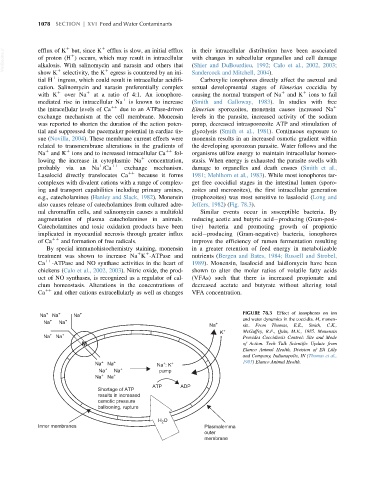Page 1146 - Veterinary Toxicology, Basic and Clinical Principles, 3rd Edition
P. 1146
1078 SECTION | XVI Feed and Water Contaminants
1
1
VetBooks.ir efflux of K but, since K efflux is slow, an initial efflux in their intracellular distribution have been associated
1
of proton (H ) occurs, which may result in intracellular
with changes in subcellular organelles and cell damage
alkalosis. With salinomycin and narasin and others that
(Shier and DuBourdieu, 1992; Calo et al., 2002, 2003;
1
1
show K selectivity, the K egress is countered by an ini- Sandercock and Mitchell, 2004).
1
tial H ingress, which could result in intracellular acidifi- Carboxylic ionophores directly affect the asexual and
cation. Salinomycin and narasin preferentially complex sexual developmental stages of Eimerian coccidia by
1 1 1 1
with K over Na at a ratio of 4:1. An ionophore- causing the normal transport of Na and K ions to fail
mediated rise in intracellular Na 1 is known to increase (Smith and Galloway, 1983). In studies with free
the intracellular levels of Ca 11 due to an ATPase-driven Eimerian sporozoites, monensin causes increased Na 1
exchange mechanism at the cell membrane. Monensin levels in the parasite, increased activity of the sodium
was reported to shorten the duration of the action poten- pump, decreased intrasporozoite ATP and stimulation of
tial and suppressed the pacemaker potential in cardiac tis- glycolysis (Smith et al., 1981). Continuous exposure to
sue (Novilla, 2004). These membrane current effects were monensin results in an increased osmotic gradient within
related to transmembrane alterations in the gradients of the developing sporozoan parasite. Water follows and the
1
1
Na and K ions and to increased intracellular Ca 11 fol- organisms utilize energy to maintain intracellular homeo-
lowing the increase in cytoplasmic Na 1 concentration, stasis. When energy is exhausted the parasite swells with
1 11
probably via an Na /Ca exchange mechanism. damage to organelles and death ensues (Smith et al.,
11
Lasalocid directly translocates Ca because it forms 1981; Mehlhorn et al., 1983). While most ionophores tar-
complexes with divalent cations with a range of complex- get free coccidial stages in the intestinal lumen (sporo-
ing and transport capabilities including primary amines, zoites and merozoites), the first intracellular generation
e.g., catecholamines (Hanley and Slack, 1982). Monensin (trophozoites) was most sensitive to lasalocid (Long and
also causes release of catecholamines from cultured adre- Jeffers, 1982)(Fig. 78.3).
nal chromaffin cells, and salinomycin causes a multifold Similar events occur in susceptible bacteria. By
augmentation of plasma catecholamines in animals. reducing acetic and butyric acid producing (Gram-posi-
Catecholamines and toxic oxidation products have been tive) bacteria and promoting growth of propionic
implicated in myocardial necrosis through greater influx acid producing (Gram-negative) bacteria, ionophores
11
of Ca and formation of free radicals. improve the efficiency of rumen fermentation resulting
By special immunohistochemistry staining, monensin inagreater retentionoffeedenergyinmetabolizable
1 1
treatment was shown to increase Na K -ATPase and nutrients (Bergen and Bates, 1984; Russell and Strobel,
Ca 11 -ATPase and NO synthase activities in the heart of 1989). Monensin, lasalocid and laidlomycin have been
chickens (Calo et al., 2002, 2003). Nitric oxide, the prod- shown to alter the molar ratios of volatile fatty acids
uct of NO synthases, is recognized as a regulator of cal- (VFAs) such that there is increased propionate and
cium homeostasis. Alterations in the concentrations of decreased acetate and butyrate without altering total
Ca 11 and other cations extracellularly as well as changes VFA concentration.
Na + Na + Na + FIGURE 78.3 Effect of ionophores on ion
Na + Na + and water dynamics in the coccidia. M, monen-
Na + sin. From Thomas, E.E., Smith, C.K.,
K + McGuffey, R.F., Quin, M.E., 1985. Monensin
Na + Na + Provides Coccidiosis Control: Site and Mode
M of Action. Tech Talk Scientific Update from
Elanco Animal Health, Division of Eli Lilly
and Company, Indianapolis, IN (Thomas et al.,
Na + Na + Na : K + 1985) Elanco Animal Health.
+
Na + Na + pump
Na + Na +
ATP ADP
Shortage of ATP
results in increased
osmotic pressure
ballooning, rupture
H O
2
Inner membranes Plasmalemma
outer
membrane

